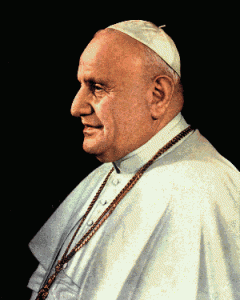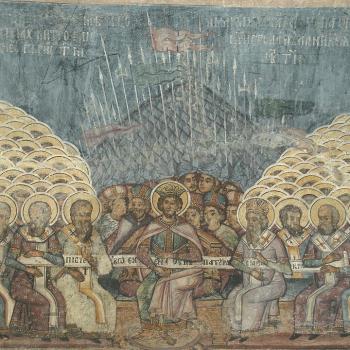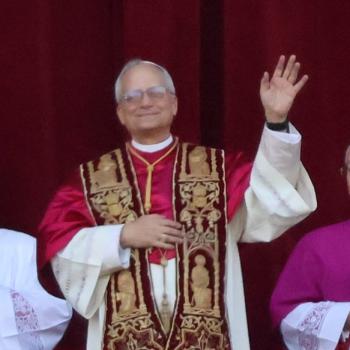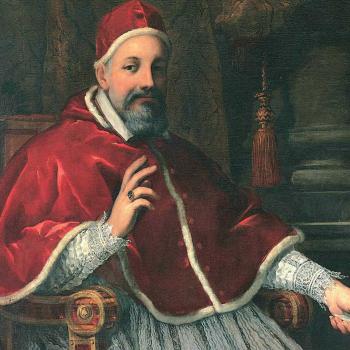
Two noteworthy anniversaries are marked this month: the 50th anniversary of the opening of the Second Vatican Council, which occurred on October 11, 1962, and the 495th anniversary of the Protestant Reformation, widely recognized on October 31, but transferred and celebrated by many churches as “Reformation Sunday.” (This year it occurs on the 27th). Admittedly, the latter anniversary perhaps only gains greater purchase on our imagination now as it betokens the epochal 500th anniversary, which will be marked worldwide in 2017.
Concerning the latter, Mark Noll of the University of Notre Dame and I have planned a conference that will take place at Gordon College, where I teach, in November of 2013. Titled “Protestantism? Reflections in Advance of the 500th Anniversary of the Protestant Reformation: 1517-2017,” the conference, we hope, will lay groundwork for asking the “big questions” about the Reformation that inexorably will arise as 2017 draws near. As we have surveyed the road ahead: “The world is fast approaching an epochal date: 31 October 2017, the quincentennial of the Protestant Reformation. Countries, social movements, churches, universities, seminaries, and other institutions shaped by Protestantism face a daunting challenge: how best to commemorate the Reformation 500 years after the fact. . . . The upcoming anniversary provides a propitious moment to take stock of the ‘big picture’ and frame lines of inquiry relevant to understanding the ‘social memory’ of the Reformation.”
For now though, the Reformation can wait, as it is the 50th anniversary of Vatican II that knocks on the door. Upon closer reflection, however, the two anniversaries are connected, for one of the most significant historical realities that the Reformation quincentennial will have to reckon with is the stunning event that was Vatican II (1962-65).
Popular accounts of postconciliar Catholicism tend to focus on the hot-button issues (female ordination, contraception, clerical celibacy) and divide the Church between the children of light (progressives, who saw Vatican II as a down payment on more far-reaching reforms) and the children of darkness (conservatives, who worried that Vatican II itself went a step too far). This is lazy Whig history, injurious to more sober historical and theological assessments of Vatican II. For starters, one at least ought to familiarize oneself with the guiding ideas behind the Council called by John XXIII. These are usually rendered in two foreign words: the Italian aggiornamento or, loosely, bringing the Church into dialogue with the modern world, and the French ressourcement or, loosely, seeking older sources (especially from the patristic period) for helping the Church think through contemporary challenges.
With an eye toward the Reformation anniversary, two of the sixteen documents produced at Vatican II hold special significance: Lumen gentium, the constitution on ecclesiology or the nature of the Church and Unitatis redintegratio, the decree on ecumenism or the question of Christian unity. Both documents, in my humble opinion, helped address certain Reformation-era critiques and moved the Catholic Church in the direction, if not in the immediate vicinity, of Protestantism or certain strands thereof. Lumen gentium or “the Light of the Nations” stepped back from the highly juridical ecclesiology emphasized at the Council of Trent (1545-63) and the First Vatican Council (1860-70). In its place, the bishops asserted that the “Mystery of the Church” should regain a greater understanding of itself (prelates, priests, and laity) as “the people of God,” guided by the Holy Spirit. What is more, Lumen gentium moved away from the Tridentine view of the Roman Catholic Church as “being” (est) the true Church to a view that saw the fullness of the Church universal as “subsisting in” (subsistit in) in the Roman Catholic Church. A small distinction perhaps, but a necessary one for Unitatis redintegratio, which allowed for a more generous appraisal of non-Catholic Christians. This document unprecedentedly proclaims that “both sides were to blame” for the breach of the sixteenth century and that greater cooperation and dialogue with “separated brethren” was essential. The Council elaborated:
The children who are born into these [Protestant] Communities and who grow up believing in Christ cannot be accused of the sin involved in the separation, and the Catholic Church embraces upon them as brothers, with respect and affection. . . . . Moreover, some and even very many of the significant elements and endowments which together go to build up and give life to the Church itself, can exist outside the visible boundaries of the [Roman] Catholic Church: the written word of God; the life of grace; faith, hope and charity, with the other interior gifts of the Holy Spirit, and visible elements too. All of these, which come from Christ and lead back to Christ, belong by right to the one Church of Christ.
Since Vatican II, ecumenical efforts have been sadly a mixed bag. On the one hand, numerous statements of cooperation and understanding have been issued between the Catholic Church and various Protestant bodies, spearheaded from the Catholic side by the Pontifical Council for the Promotion of Christian Unity. John Paul II’s encyclical Ut unum sint (1995), moreover, represented a bold restatement and elaboration of Unitatis redintegratio. In the United States, a notable cooling of evangelical-Catholic tensions has taken place, motivated in part by what the Baptist theologian Timothy George has famously called an “ecumenism of the trenches,” a common ethical front against various moral depredations. Even so, many of the theological hopes and longings of Vatican II remain elusive or else cheapened by an overweening inclination on the part of some to purchase unity at the price of ignoring genuine differences.
At the very least, as we remember Vatican II and prepare to remember the Reformation at 500, let me suggest it is the duty of all educated Christians to read up on Vatican II. Now is a particularly propitious moment to do so and one can begin at the Vatican’s website here. Perhaps the unity of the Church is, finally, only an eschatological reality. But for allChristians who pray “thy Kingdom come,” something as trifling as the practically impossible should never stand in the way of the theologically necessary. Let this season of commemorations begin.












